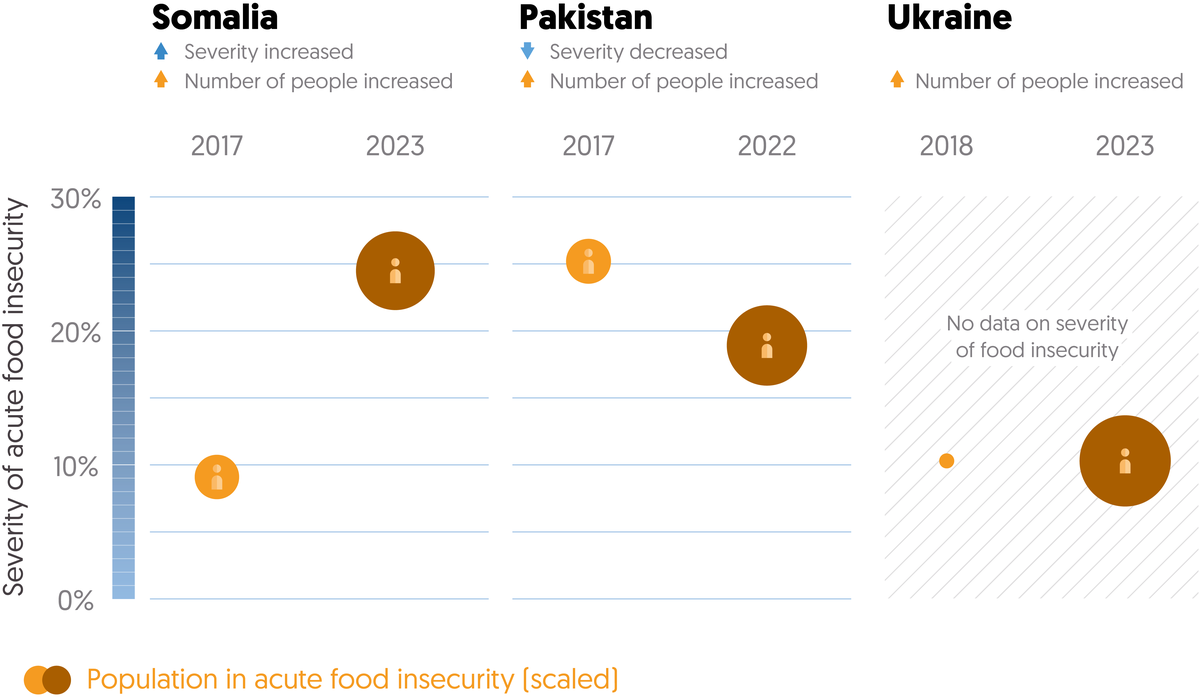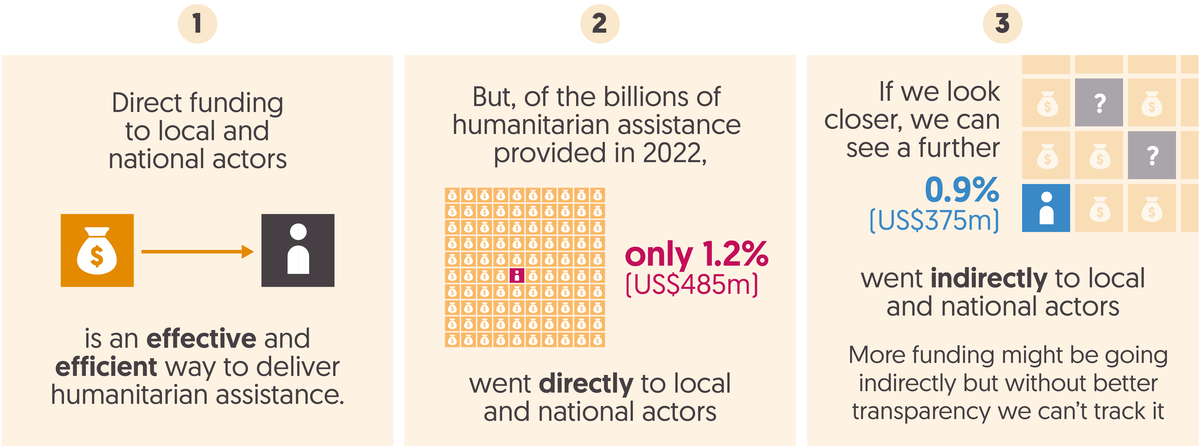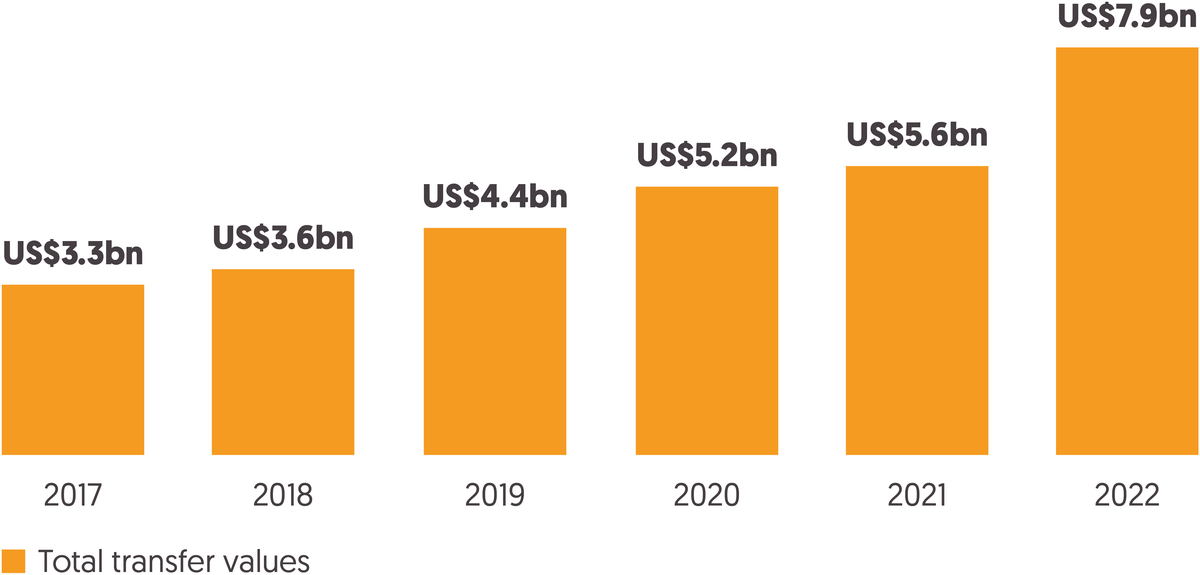Read our latest report on humanitarian finance and reform
Our new report 'Falling short? Humanitarian funding and reform' presents the latest data on global humanitarian assistance, as well as progress on Grand Bargain localisation targets, cash and voucher assistance, and anticipatory action.
Read the reportIn 2022, the demand for humanitarian assistance grew larger than ever. There was an exceptional donor response to the unprecedented increase in the number of people in need – driven largely by the war in Ukraine as well as worsening crises in Afghanistan and the Horn of Africa. Yet the scale of need meant the shortfall in humanitarian funding reached a record high.
There is a growing number of complex, long-term crises. And the pressure placed on the humanitarian system to respond is only set to increase in 2023. This strain is being driven by continued system-wide shocks, including climate change and the war in Ukraine, and new and escalating crises, such as the devastating earthquakes in Türkiye and Syria and the worsening conflict in Sudan. The imperative for significant change to humanitarian funding and response – and to better address the long-term root causes of, and recovery from, crises – is obvious and recognised but more pressing than ever.
What change needs to take place? In this report, we invite key leaders in the humanitarian sector to reflect on, and react to, our stark analysis and propose ways forward for change. Ideas to address the humanitarian financing gap include establishing humanitarian funding targets to encourage more equitable burden sharing and repositioning the narrative around humanitarian assistance as an investment in resilience, to widen the donor base. Other proposals focus on the need to double-down efforts to reform the system, including the need to shift current business models to support greater local humanitarian leadership – for instance by identifying more effective local funding solutions such as locally managed global pooled funds. Looking beyond humanitarian assistance, ideas for change reinforce the need to build the resilience of affected communities through long-term development strategies and mobilising funding for anticipatory action and additional climate finance, including through the new Loss and Damage Fund. Some proposals centre on the need to ensure access to flexible, multi-year funding, so that local organisations can increase preparedness to shocks and respond flexibly to the needs of their communities while maintaining a focus on building capacities to mitigate impacts of future crises.
This summary of the Global Humanitarian Assistance Report 2023 presents key findings about:
- Trends in humanitarian need and crisis in 2022
- Trends in humanitarian funding
- Progress made on commitments to a better humanitarian system, with a focus on locally led action
- How resources beyond humanitarian funding – such as climate finance – could be used to address cycles of crises.
Box 1
About this report
This year’s report includes, for the first time, contributions from external stakeholders. These ‘Insight’ pieces contextualise the report’s findings, comment on the real-world implications, and propose ideas and solutions for change.
The full report provides deeper data-driven analysis of humanitarian need and funding. It examines how funding has been mobilised, how and to whom it has been delivered, and how, through the Grand Bargain, efforts to provide assistance more efficiently and effectively have progressed. It also examines how development and climate finance are being deployed to countries experiencing humanitarian crisis.
You can explore the data behind the report using our interactive data tools .
Humanitarian need and crises
How have levels of humanitarian need changed in 2022?
A third more people were in need of humanitarian assistance in 2022, with most facing long-term crisis
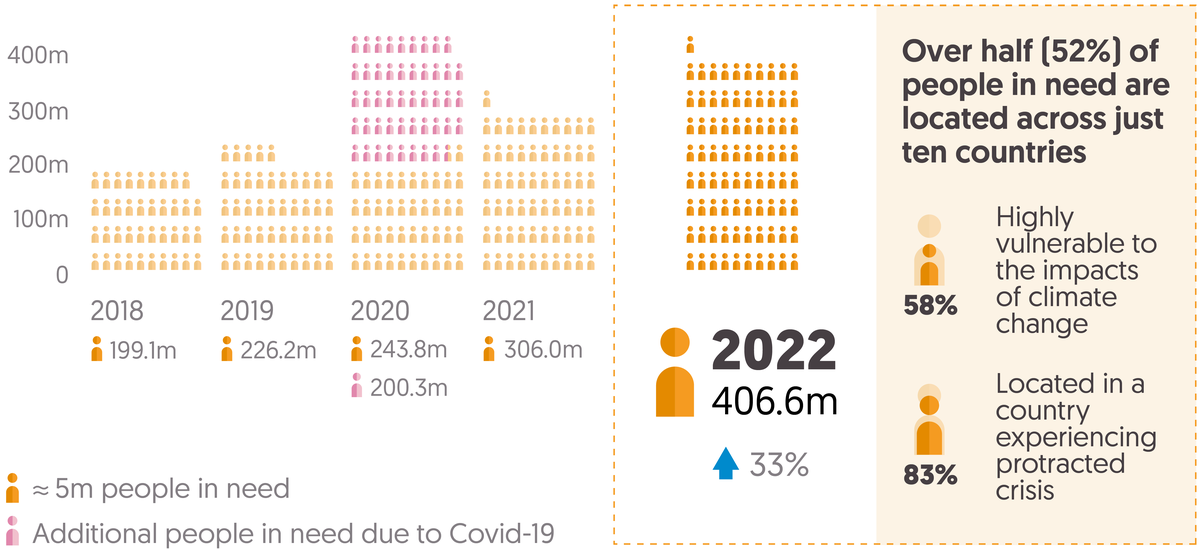
Infographic showing growth in numbers of people in need in 2022, with 52% of all people in need located in ten countries; 58% highly vulnerable to the impacts of climate change and 83% located in a country experiencing protracted crisis.
In Chapter 1 , we explore how the number of men, women and children in need of humanitarian assistance has more than doubled over the last five years. In 2022 alone, this number grew by a third to an estimated 406.6 million people. Data on gender and age is available for just a third of UN-coordinated appeals. But where this data exists it shows that half of people in need are children under the age of 18 (49%, or 90 million). Several large-scale protracted crises account for the bulk of humanitarian needs, with more than half of all people in need over the past five years living in just 10 countries.
► Insight: Read more in Chapter 1, where Jan Egeland, Secretary General of the Norwegian Refugee Council and outgoing Eminent Person of the Grand Bargain, proposes the need to change the narrative around humanitarian need to address the growing humanitarian funding gap .
What has driven need?
A growing number of people in need face intersecting threats from conflict, climate change and socioeconomic vulnerability
As new shocks follow and compound existing crises, affected people are increasingly vulnerable as their resilience and ability to cope is eroded. In 2022, three-quarters of all people in need of humanitarian assistance faced at least two risk dimensions: conflict, climate and/or socioeconomic vulnerability. This means that most crises are now long-term; a growing majority of people in need (83%) live in a country that has had a UN-coordinated appeal for five or more consecutive years.
► Insight: Read more about the implications of recurrent crises in Chapter 1, where Albashir Ibrahim, Executive Director of NEXUS Consortium in Somalia, reinforces the importance of taking an integrated approach to humanitarian, development and peace programming to build the self-reliance of communities and reduce dependence on humanitarian assistance .
One of the primary drivers of need in 2022 was food insecurity; the number of people experiencing severe food insecurity continued to grow, driven by the war in Ukraine and a food crisis in the Horn of Africa. An estimated 265.7 million people were facing crisis-level acute food insecurity in 2022/23. This is more than double the number of people (115.2 million people) facing this level of food insecurity in 2019, before the Covid-19 pandemic. In Chapter 2 , we demonstrate why the severity of food insecurity – as well as the number of people experiencing it – should inform how responses are targeted. These two factors do not always correlate. In Somalia, the number of people affected rose from 2.6 to 8.3 million, and the severity of food insecurity increased more than in any other country. However, in Pakistan, where a similar rise in the number of people experiencing food insecurity (from 2.7 to 8.6 million) occurred, there was a significant decrease in the severity of food insecurity.
► Insight: Read more in Chapter 2 where N4D highlight the importance of local ownership and long-term financing in multi-sector nutrition programming, drawing on their experiences in Yemen .
Forced displacement also continued to drive rising levels of humanitarian need. An additional 16.5 million people were displaced internally or across borders in 2022; over 10 million of these were people affected by the war in Ukraine.
Humanitarian funding trends
How much international humanitarian assistance was there in 2022?
International humanitarian assistance grew by more than a quarter in 2022
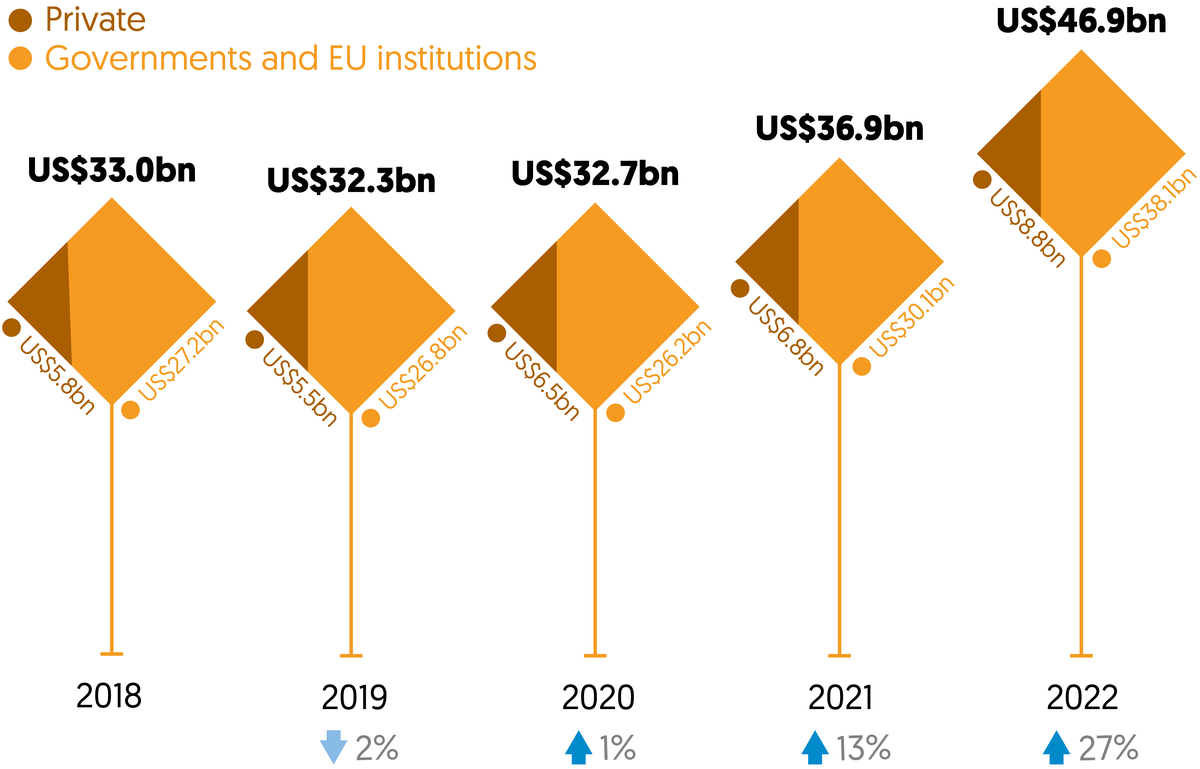
Stylised column chart showing significant increase in total volume of international humanitarian assistance in 2022 compared to previous 4 years. Also shows split between private and public assistance, with proportions staying relatively constant between 2018 and 2022.
Both public and private donors gave substantially more humanitarian funding in 2022. Total international humanitarian assistance (from public and private donors) increased by US$10.0 billion (27%) to US$46.9 billion. This pace of growth marks a significant departure from much slower growth trends in recent years.
The increase in funding was in response to appeal requirements in 2022 that stood at a record US$52.4 billion, an increase of 37% from 2021. This was driven in part by the significant jump in funding requested through the Ukraine, Afghanistan, Ethiopia and Somalia appeals. At the time of writing, requirements for 2023 have already eclipsed this, with a total US$54.9 billion requested to meet new and worsening crises. Despite the unprecedented response, driven partly by strong donor solidarity with Ukraine, the appeals funding shortfall grew to a record US$22.1 billion in 2022.
Who provided international humanitarian assistance?
Public donors gave more than ever in 2022, with most making large increases in the volume of funding
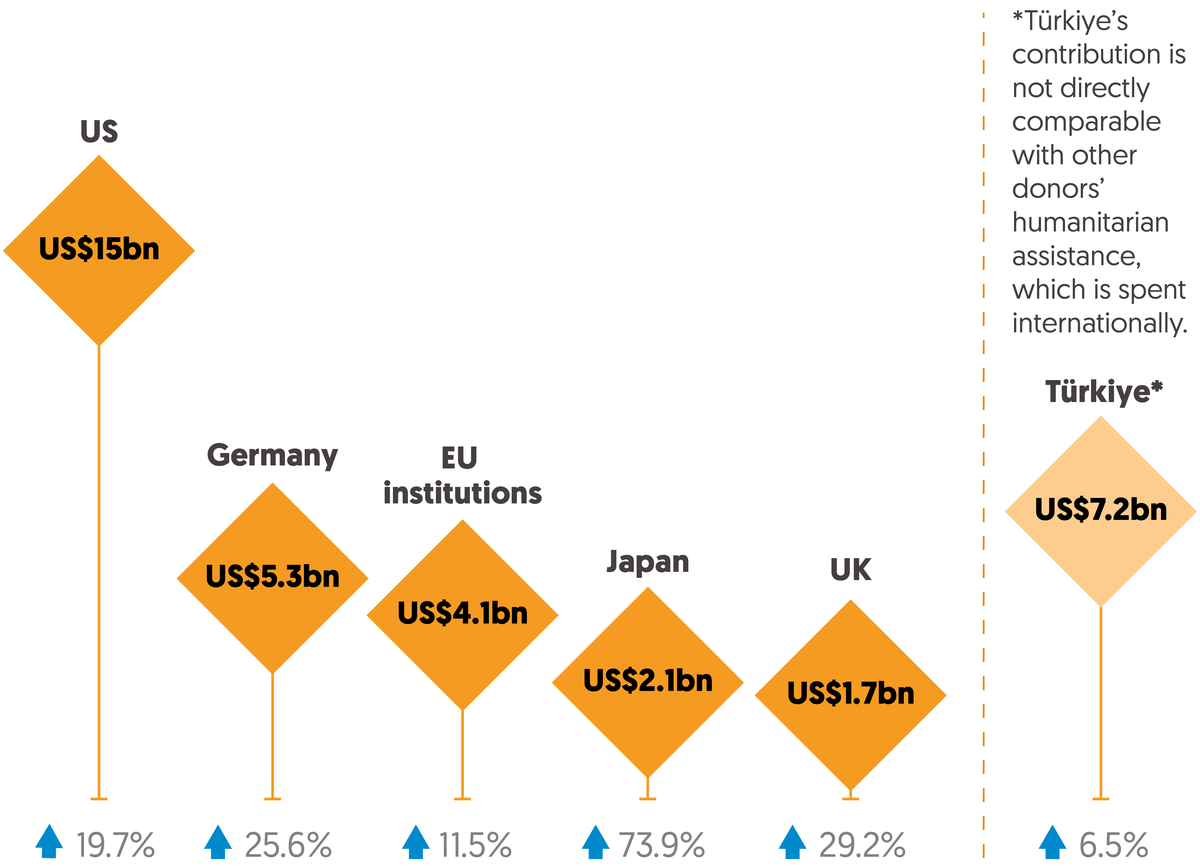
Stylised column chart showing largest donors of international humanitarian assistance, with US (US$15 billion), Germany (US$5.3 billion), EU institutions (US$4.1 billion), Japan (US$2.1 billion) and UK (US$1.7 billion).
Nearly all the top 20 public donors increased their contributions in 2022, with over half increasing assistance by more than 20%. However, the humanitarian funding system remains reliant on a small number of donors. The three largest – the US, Germany and EU institutions [1] – together accounted for 64% of total international humanitarian assistance from public donors, with the US alone providing 39%.
► Insight: Read more in Chapter 2, where Michael Köhler, Deputy Director of the Department of Humanitarian Aid and Civil Protection (ECHO), proposes to establish national funding targets as a way of building peer pressure, making donor contributions more comparable and widening the donor base .
Donors are faced with a complex set of choices in how and where to allocate their funding. In 2022 there was significant variation between the largest donors in the share of their total assistance allocated at the country and the global or regional levels. The US, EU institutions and UK allocated almost all assistance to specific country contexts with 6% or less provided at the global or regional level. This compares with Japan, which allocated 55% of assistance to the global or regional level, and Germany, which allocated 17%. There is also notable variation in how donors choose to allocate funding to individual crises.
As a result of this increased humanitarian funding, the proportion of official development assistance (ODA) from the Organisation for Economic Co-operation and Development (OECD) Development Assistance Committee (DAC) members provided as international humanitarian assistance grew to 17% (US$36.4 billion) from 15% (US$27.9 billion) in 2021. Donors also spent more ODA on hosting refugees within their own countries – this expenditure more than doubled in 2022 to US$30.1 billion.
Where did international humanitarian assistance go?
10 countries received almost two-thirds of all funding, with Ukraine receiving the largest ever volume in one year
The largest recipient of humanitarian funding in 2022 was Ukraine – receiving the highest volume of contributions ever recorded in one year (US$4.4 billion). As in previous years, a small number of large long-term crises absorbed the majority of funding – in 2022, the 10 largest recipients of humanitarian assistance received 63% of total country-allocable funding. In addition to Ukraine, four countries (Afghanistan, Yemen, Syria and Ethiopia) received more than US$2 billion each in humanitarian funding.
Improving the delivery of humanitarian assistance
How was humanitarian assistance channelled?
The volume and share of funding provided to UN agencies increased in 2022
In the context of rapidly growing requirements and limited resources, the need to ensure that humanitarian assistance is delivered as effectively and efficiently as possible is more urgent than ever. UN agencies continued to receive the majority of funding from public donors. In 2022, the share of funding they received grew from 52% in 2021 to 61% (US$22.8 billion). Despite calls for better reporting, generally there is inadequate data on how this funding is passed on.
► Insight: Read more in Chapter 3 where Hibak Kalfan, Executive Director of NEAR , reinforces the need to recentre the current humanitarian model around local communities .
► Insight: In Chapter 3, the Feminist Humanitarian Network set out the unique challenges faced by women’s rights civil society organisations in accessing international funding and urges donors to provide more multi-year, flexible funding .
What progress has been made towards more locally led humanitarian action?
As we show in Chapter 3 , progress against commitments to support greater local humanitarian leadership through increasing funding to local and national actors has been disappointing. There was no increase in the proportion of total international humanitarian assistance provided directly to local and national actors in 2022, which stood at just 1.2% (US$485 million). It remains difficult to know how much funding reaches local and national actors indirectly – through one or more intermediary organisation – due to incomplete reporting.
However, funding allocated to local and national actors through the UN’s Office for the Coordination of Humanitarian Affairs (OCHA) pooled funds did increase – 28% of direct allocations of the country based pooled funds in 2022 and a preliminary 18% of the Central Emergency Response Fund allocations were sub-granted in 2021.
More positively, shifts in practice are occurring. Some momentum for change is building to provide more equitable access to unrestricted funding for non-project costs (i.e., overheads) for local and national partners.
► Insight: Read more in Chapter 2 where The Organisation for Children Harmony (TOCH) from South Sudan share their experiences of accessing the UN South Sudan Humanitarian Fund and call for more multi-year funding .
► Insight : In Chapter 3, Virginie Lefèvre of Amel Association International also advocates for overhead funding for local and national actors .
How was humanitarian assistance delivered?
The steady growth seen since 2017 in the provision of humanitarian assistance as cash and vouchers continued in 2022. The use of cash and vouchers rose in response to the Ukraine conflict and rising levels of food insecurity, increasing by a record 40% to US$7.9 billion in 2022. Cash and vouchers accounted for an estimated 20% of total humanitarian assistance in 2022.
Wider crisis funding
What resources beyond humanitarian assistance are reaching countries in crises?
Countries facing long-term crisis receive a growing share of their aid as humanitarian assistance over funding for development and peace
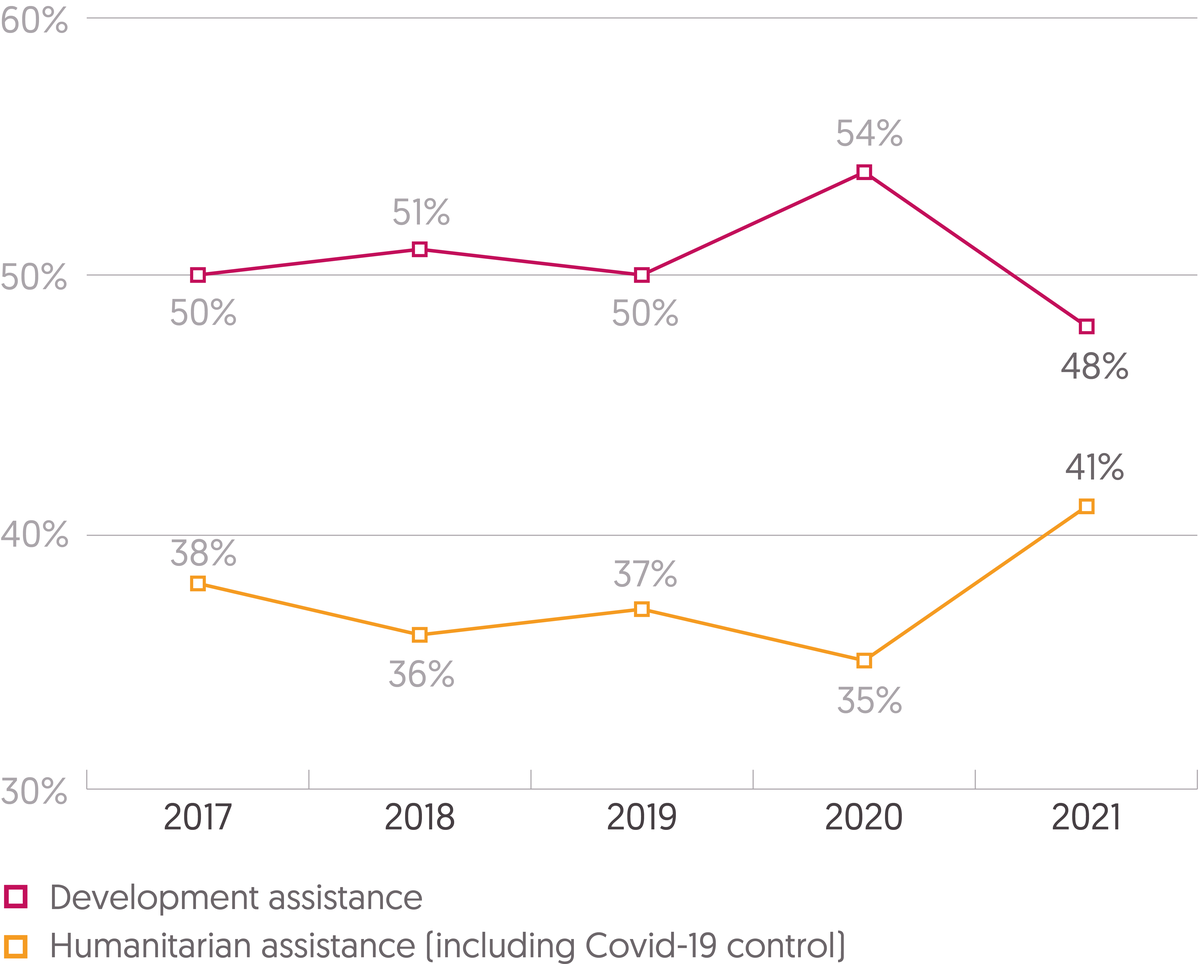
Line chart showing that countries facing long term crisis received less aid as development assistance in 2021 and more as humanitarian assistance, after a previous rise in development assistance in 2020.
Countries facing humanitarian crisis are also recipients of development, peace and climate financing. In Chapter 4 , we explore how balancing these funding flows correctly is critical to ensuring that urgent needs are met, while also addressing the root causes of crisis and building resilience to shocks. Countries facing long-term crisis have not seen a notable transition from humanitarian to longer-term development assistance. Between 2017 and 2021, the volume and proportion of development assistance received by countries facing long-term crisis reduced (by US$0.6 billion and from 50% to 48%), while the volume and proportion of total ODA received as humanitarian assistance increased – reaching 41% in 2021, compared to an average of 37% over the past five years .
What climate finance is reaching countries in crisis?
Of the countries most vulnerable to climate change, those that also face long-term humanitarian crises receive less climate funding
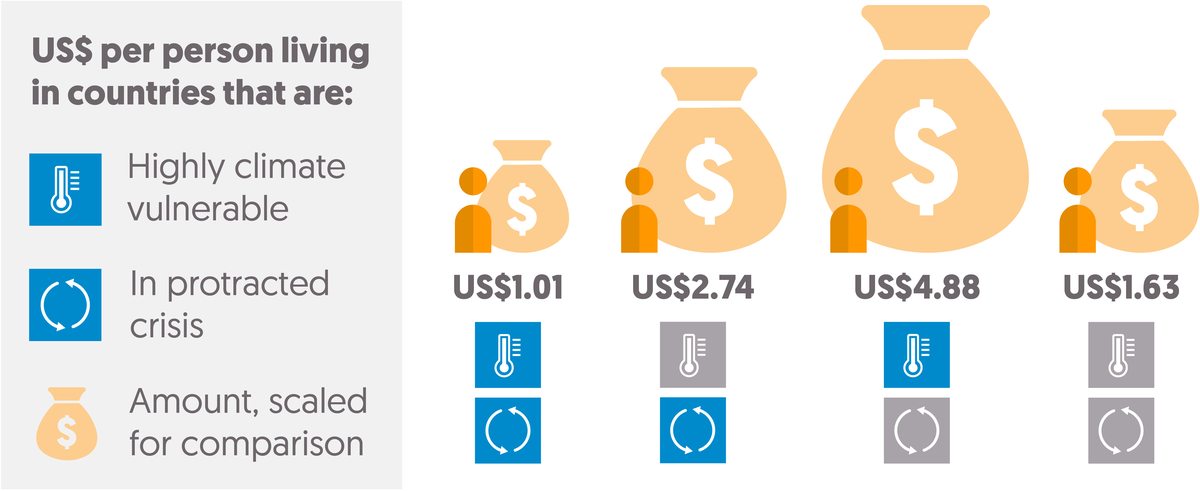
Infographic showing that most climate finance is received by people in highly climate vulnerable countries, with significantly less received by those in countries which are both highly climate vulnerable and in protracted crisis.
► Use our interactive chart to reveal vulnerability to the impacts of climate change, volumes of climate finance (ODA) by country, and how specific risk and geographic groups fare.
The accelerating impacts of climate change are driving new crises and compounding existing risks. Despite this, countries that are most vulnerable to climate-related shocks are not receiving the necessary funding to prepare for and alleviate these shocks. People in countries experiencing protracted crisis and a high level of climate vulnerability receive a lower proportion of their total ODA as climate finance than other climate-vulnerable countries. They also receive less finance from multilateral climate funding mechanisms and less per capita multilateral climate finance: US$1 per person, compared to US$4.88 per person in the most climate-vulnerable countries not experiencing long-term crisis.
► Insight: Read more in Chapter 4, where Harjeet Singh from the Climate Action Network calls for new and additional loss and damage finance to address the impacts of climate disasters .
Funding can also be made available ahead of time for predictable hazards to reduce humanitarian impacts. This type of anticipatory action, such as disaster risk reduction (DRR), is essential alongside climate and humanitarian funding to support response, recovery and resilience building. Despite this, 2022 saw the volume of ODA provided for DRR fall for the first time in four years to US$3.0 billion, driven by large reductions from key donors including the UK and the World Bank.
► Insight : Read more in Chapter 4, where Christina Bennett from Start Network comments on the importance of anticipatory action evidenced by the impact of the heatwave risk finance system of Start Network’s Pakistan Hub .
Read the full report for more in-depth analysis on key trends in humanitarian and wider crisis funding and use our interactive tool to explore the data in more detail.
Sign up to our mailing list to receive updates of our work and visit Development Initiatives’ website for more resources related to humanitarian assistance.
Read our latest report on humanitarian finance and reform
Our new report 'Falling short? Humanitarian funding and reform' presents the latest data on global humanitarian assistance, as well as progress on Grand Bargain localisation targets, cash and voucher assistance, and anticipatory action.
Read the reportNotes
-
1
EU institutions, as defined by the OECD DAC, includes the European Commission (and all sub-entities including DG ECHO and DG INTPA), the European External Action Service, and the European Investment Bank. For more detail see: https://www.oecd-ilibrary.org/sites/c0ad1f0d-en/index.html?itemId=/content/component/5e331623-en& csp =b14d4f60505d057b456dd1730d8fcea3&itemIGO=oecd&itemContentType=chapterReturn to source text
